Nursing Theories: Hildegard Peplau's Interpersonal Relations Theory
VerifiedAdded on 2023/04/22
|10
|826
|269
Report
AI Summary
This report provides an overview of Hildegard Peplau's interpersonal relations theory in nursing. It explains the core concept of the theory, which focuses on the therapeutic relationship between a nurse and a patient, and the phases involved, including orientation, identification, exploitation, and termination. The report also discusses the metaparadigm concepts of nursing, person, health, and environment within Peplau's framework. Furthermore, it presents examples of the theory's application in treating conditions like anemia in schoolchildren and caring for geriatric patients, supported by evidence from various studies. The importance of establishing a strong nurse-patient relationship to improve patient outcomes is emphasized throughout the analysis.

Nursing theories
Paraphrase This Document
Need a fresh take? Get an instant paraphrase of this document with our AI Paraphraser
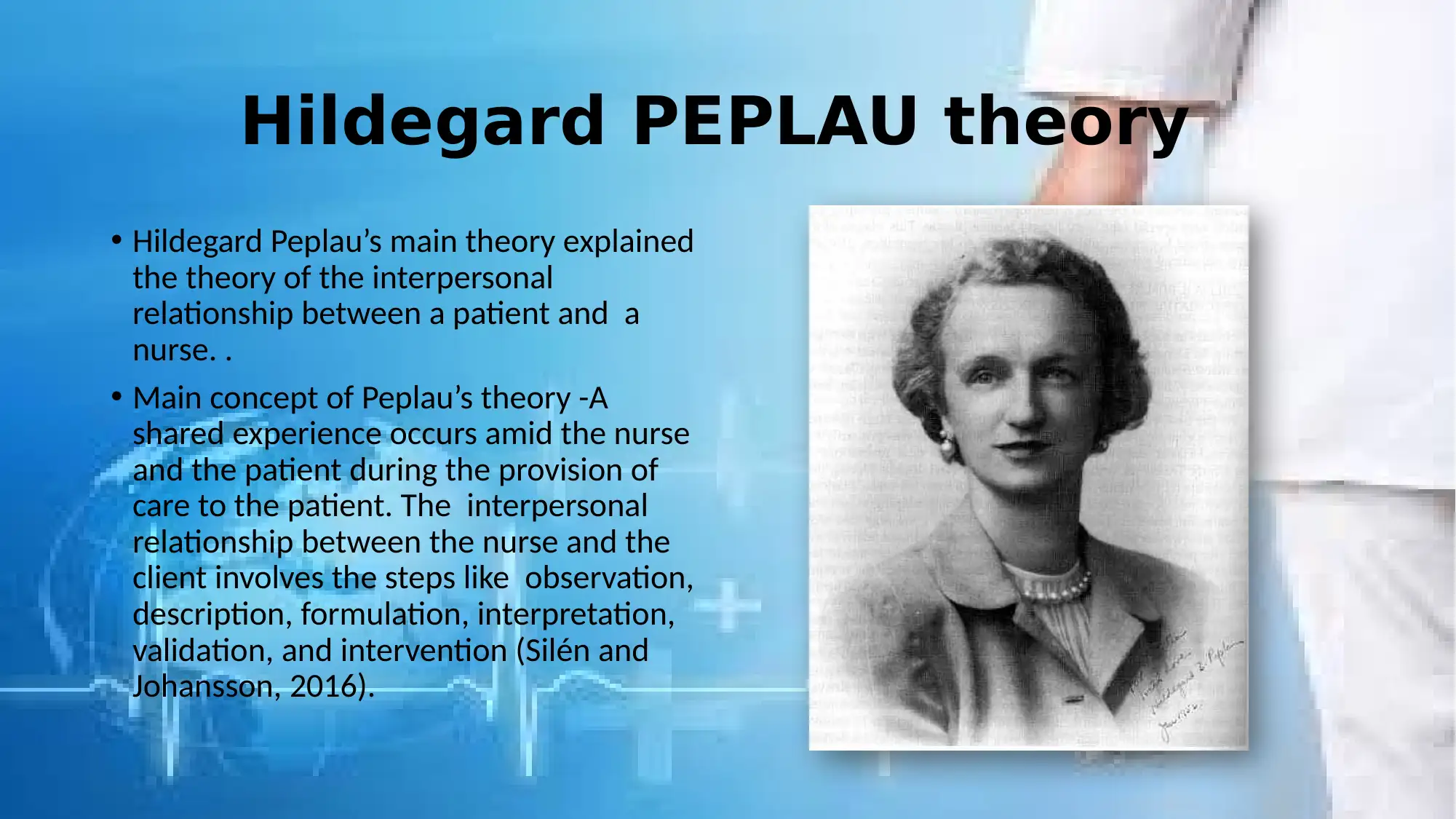
Hildegard PEPLAU theory
• Hildegard Peplau’s main theory explained
the theory of the interpersonal
relationship between a patient and a
nurse. .
• Main concept of Peplau’s theory -A
shared experience occurs amid the nurse
and the patient during the provision of
care to the patient. The interpersonal
relationship between the nurse and the
client involves the steps like observation,
description, formulation, interpretation,
validation, and intervention (Silén and
Johansson, 2016).
• Hildegard Peplau’s main theory explained
the theory of the interpersonal
relationship between a patient and a
nurse. .
• Main concept of Peplau’s theory -A
shared experience occurs amid the nurse
and the patient during the provision of
care to the patient. The interpersonal
relationship between the nurse and the
client involves the steps like observation,
description, formulation, interpretation,
validation, and intervention (Silén and
Johansson, 2016).

Peplau’s phases of
interpersonal relationship
• Orientation-Involves the Commencement
of the nurse patient liaison. Resources are
provided by the nurse on restricted way.
• Identification-In this step the patient
gradually can recognize the problems that
needs to be treated. The nurse provides
the patient with some knowledge
regarding the health care status.
interpersonal relationship
• Orientation-Involves the Commencement
of the nurse patient liaison. Resources are
provided by the nurse on restricted way.
• Identification-In this step the patient
gradually can recognize the problems that
needs to be treated. The nurse provides
the patient with some knowledge
regarding the health care status.
⊘ This is a preview!⊘
Do you want full access?
Subscribe today to unlock all pages.

Trusted by 1+ million students worldwide

The phases of interpersonal
relationship
• Exploitation- The patient receives the advantage of the services
provided by the health care professionals.
• Termination-after the initial goals are met, New goals are formed. The
clients learn self manage, self care. Finally the patient is released and
the therapeutic relationship is terminated.
relationship
• Exploitation- The patient receives the advantage of the services
provided by the health care professionals.
• Termination-after the initial goals are met, New goals are formed. The
clients learn self manage, self care. Finally the patient is released and
the therapeutic relationship is terminated.
Paraphrase This Document
Need a fresh take? Get an instant paraphrase of this document with our AI Paraphraser

Metaparadigm concepts
• Phenomenon of Nursing
This concept includes the application of the nursing
interventions , the direct and the indirect care provided
(Senn, 2013). In the Peplau's theory of nursing, it is the
exploitation phase where the nurse applies all the plans
and the interventions and the patient enjoys receives the
care allotted for him/her.
• Phenomenon of Person:
According the recipient of the nursing care, person may also
include the family of the patient. friends and the
community. In the identification phase, the nurse comes to
about the strength of the family of the patient, that helps in
shared decision making.
• Phenomenon of Nursing
This concept includes the application of the nursing
interventions , the direct and the indirect care provided
(Senn, 2013). In the Peplau's theory of nursing, it is the
exploitation phase where the nurse applies all the plans
and the interventions and the patient enjoys receives the
care allotted for him/her.
• Phenomenon of Person:
According the recipient of the nursing care, person may also
include the family of the patient. friends and the
community. In the identification phase, the nurse comes to
about the strength of the family of the patient, that helps in
shared decision making.

Metaparadigm concepts
• Phenomenon of Health
The concept of health relative and depends upon the perspective of the
patient. The acceptable quality of life differs from patient to patients. In
the identification phase, the patient tallies his health condition with his
subjective perspective of health (Deane & Fain, 2016).
• Phenomenon of Environment
It is the internal and the external factors that impacts the health of a
person. The factors consists of interpersonal relationship, culture, the
immune function.
• Phenomenon of Health
The concept of health relative and depends upon the perspective of the
patient. The acceptable quality of life differs from patient to patients. In
the identification phase, the patient tallies his health condition with his
subjective perspective of health (Deane & Fain, 2016).
• Phenomenon of Environment
It is the internal and the external factors that impacts the health of a
person. The factors consists of interpersonal relationship, culture, the
immune function.
⊘ This is a preview!⊘
Do you want full access?
Subscribe today to unlock all pages.

Trusted by 1+ million students worldwide
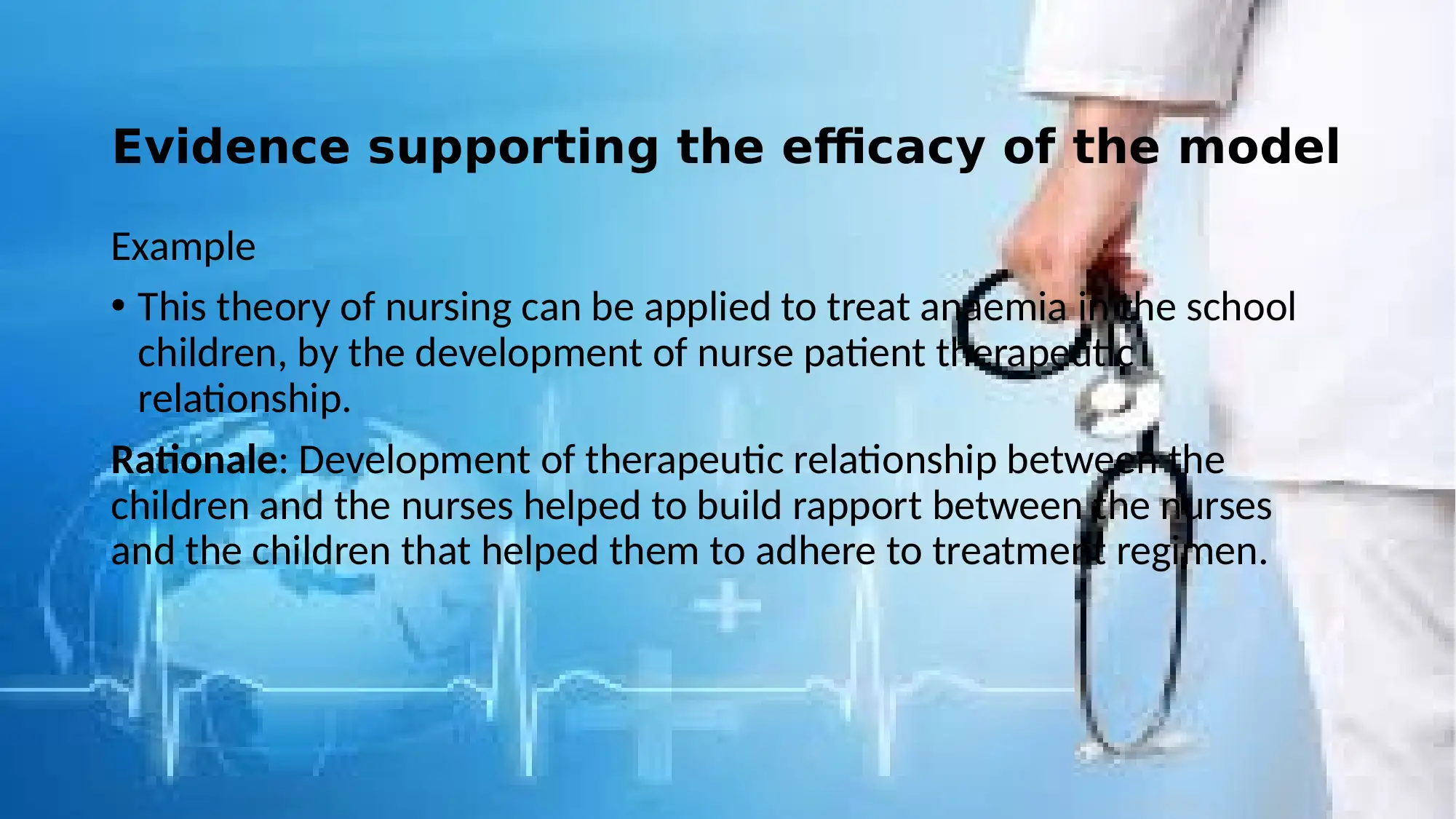
Evidence supporting the efficacy of the model
Example
• This theory of nursing can be applied to treat anaemia in the school
children, by the development of nurse patient therapeutic
relationship.
Rationale: Development of therapeutic relationship between the
children and the nurses helped to build rapport between the nurses
and the children that helped them to adhere to treatment regimen.
Example
• This theory of nursing can be applied to treat anaemia in the school
children, by the development of nurse patient therapeutic
relationship.
Rationale: Development of therapeutic relationship between the
children and the nurses helped to build rapport between the nurses
and the children that helped them to adhere to treatment regimen.
Paraphrase This Document
Need a fresh take? Get an instant paraphrase of this document with our AI Paraphraser
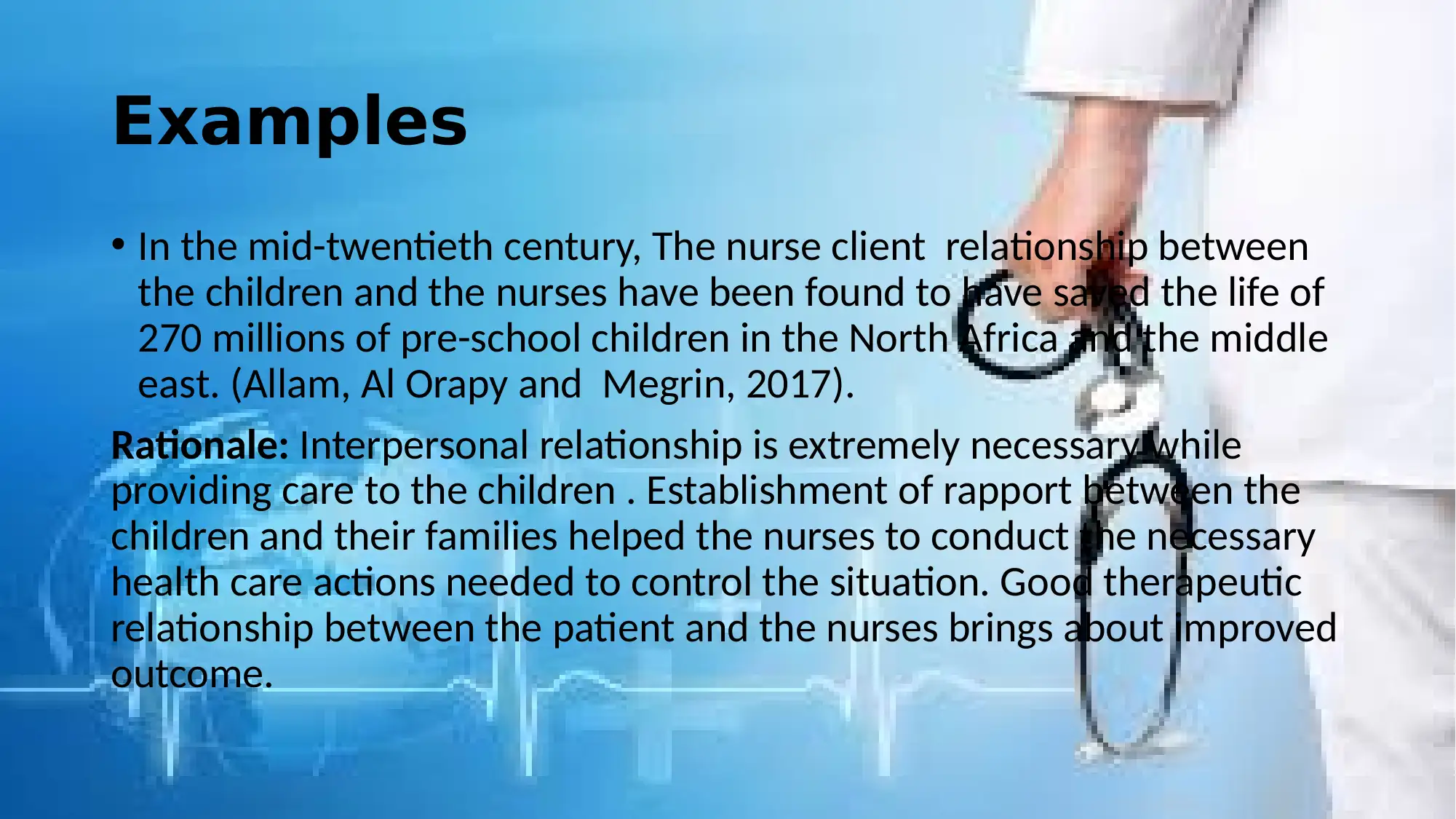
Examples
• In the mid-twentieth century, The nurse client relationship between
the children and the nurses have been found to have saved the life of
270 millions of pre-school children in the North Africa and the middle
east. (Allam, Al Orapy and Megrin, 2017).
Rationale: Interpersonal relationship is extremely necessary while
providing care to the children . Establishment of rapport between the
children and their families helped the nurses to conduct the necessary
health care actions needed to control the situation. Good therapeutic
relationship between the patient and the nurses brings about improved
outcome.
• In the mid-twentieth century, The nurse client relationship between
the children and the nurses have been found to have saved the life of
270 millions of pre-school children in the North Africa and the middle
east. (Allam, Al Orapy and Megrin, 2017).
Rationale: Interpersonal relationship is extremely necessary while
providing care to the children . Establishment of rapport between the
children and their families helped the nurses to conduct the necessary
health care actions needed to control the situation. Good therapeutic
relationship between the patient and the nurses brings about improved
outcome.
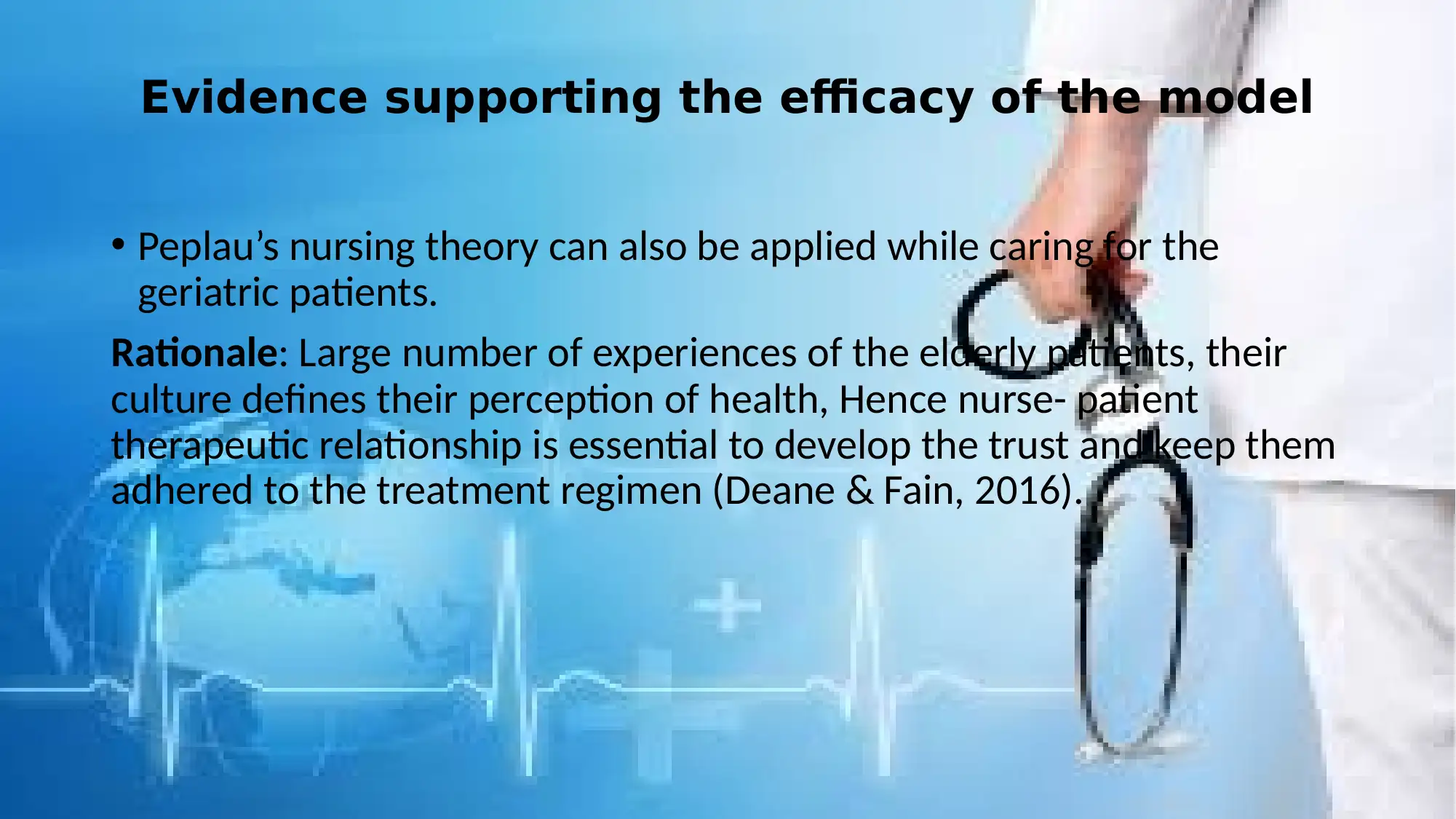
Evidence supporting the efficacy of the model
• Peplau’s nursing theory can also be applied while caring for the
geriatric patients.
Rationale: Large number of experiences of the elderly patients, their
culture defines their perception of health, Hence nurse- patient
therapeutic relationship is essential to develop the trust and keep them
adhered to the treatment regimen (Deane & Fain, 2016).
• Peplau’s nursing theory can also be applied while caring for the
geriatric patients.
Rationale: Large number of experiences of the elderly patients, their
culture defines their perception of health, Hence nurse- patient
therapeutic relationship is essential to develop the trust and keep them
adhered to the treatment regimen (Deane & Fain, 2016).
⊘ This is a preview!⊘
Do you want full access?
Subscribe today to unlock all pages.

Trusted by 1+ million students worldwide
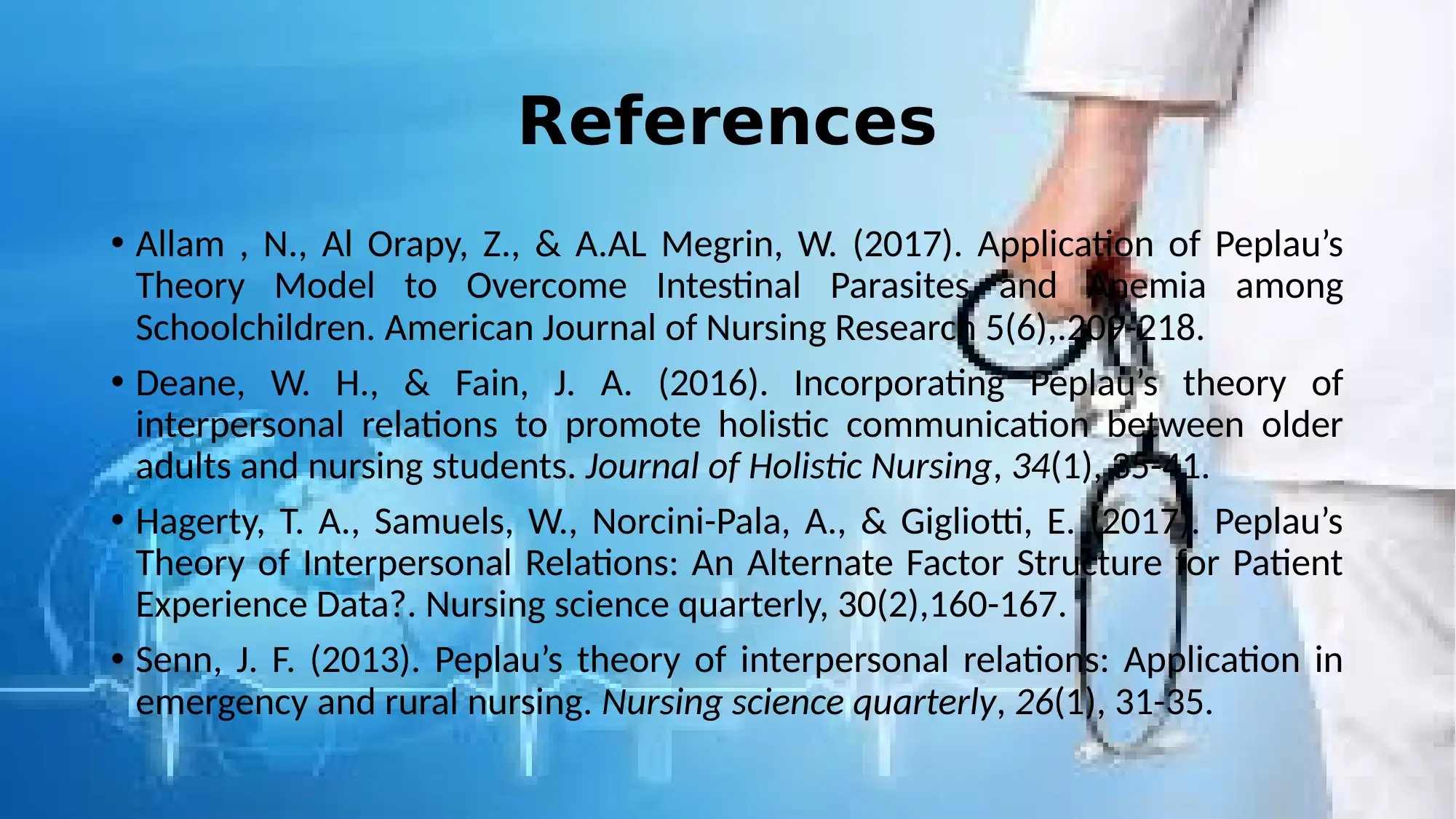
References
• Allam , N., Al Orapy, Z., & A.AL Megrin, W. (2017). Application of Peplau’s
Theory Model to Overcome Intestinal Parasites and Anemia among
Schoolchildren. American Journal of Nursing Research 5(6),.209-218.
• Deane, W. H., & Fain, J. A. (2016). Incorporating Peplau’s theory of
interpersonal relations to promote holistic communication between older
adults and nursing students. Journal of Holistic Nursing, 34(1), 35-41.
• Hagerty, T. A., Samuels, W., Norcini-Pala, A., & Gigliotti, E. (2017). Peplau’s
Theory of Interpersonal Relations: An Alternate Factor Structure for Patient
Experience Data?. Nursing science quarterly, 30(2),160-167.
• Senn, J. F. (2013). Peplau’s theory of interpersonal relations: Application in
emergency and rural nursing. Nursing science quarterly, 26(1), 31-35.
• Allam , N., Al Orapy, Z., & A.AL Megrin, W. (2017). Application of Peplau’s
Theory Model to Overcome Intestinal Parasites and Anemia among
Schoolchildren. American Journal of Nursing Research 5(6),.209-218.
• Deane, W. H., & Fain, J. A. (2016). Incorporating Peplau’s theory of
interpersonal relations to promote holistic communication between older
adults and nursing students. Journal of Holistic Nursing, 34(1), 35-41.
• Hagerty, T. A., Samuels, W., Norcini-Pala, A., & Gigliotti, E. (2017). Peplau’s
Theory of Interpersonal Relations: An Alternate Factor Structure for Patient
Experience Data?. Nursing science quarterly, 30(2),160-167.
• Senn, J. F. (2013). Peplau’s theory of interpersonal relations: Application in
emergency and rural nursing. Nursing science quarterly, 26(1), 31-35.
1 out of 10
Related Documents
Your All-in-One AI-Powered Toolkit for Academic Success.
+13062052269
info@desklib.com
Available 24*7 on WhatsApp / Email
![[object Object]](/_next/static/media/star-bottom.7253800d.svg)
Unlock your academic potential
Copyright © 2020–2025 A2Z Services. All Rights Reserved. Developed and managed by ZUCOL.





